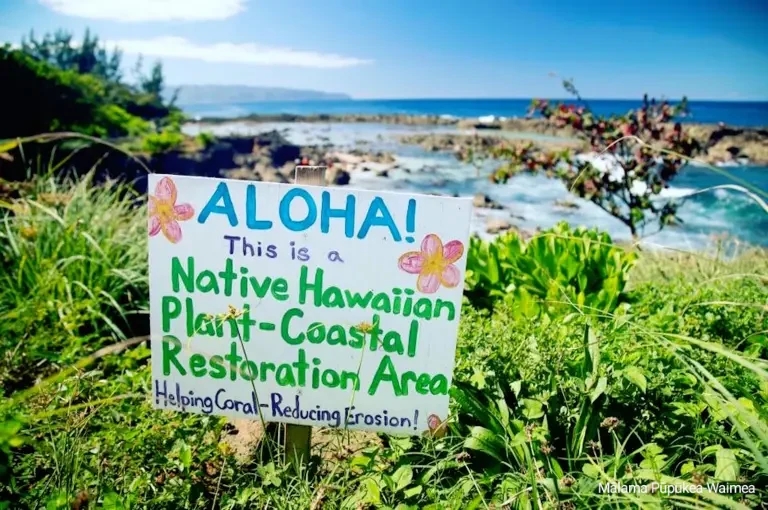Hawaii Project Resources:

Beach-building (accretion) and erosion are natural processes. The desire to live and build structures on our coastlines exposes our homes, roads, commercial and industrial facilities, shipping ports, marinas, and other buildings to shoreline erosion.
Why do we care about the erosion along our coasts?
Our coastlines are currently home to 40% of the U.S. population. There is a long trend of higher growth on the coasts. The coastal area of the U.S. is twice as developed as the rest of the country: 8.8%, versus 4.09% of the interior.
As global sea level rises, wave action and storm surge increase the likelihood of extensive coastal erosion. It is estimated that coastal erosion costs roughly $500 million per year for U.S. coastal property loss, including damage to structures and loss of land. As our climate continues to change, the increasing frequency of extreme weather threatens our shoreline communities.



The coasts of Hawaii are a stunning fusion of natural beauty, vibrant marine life, and diverse landscapes that captivate the senses. This ecological richness forms the foundation of a thriving economy, with tourism, fisheries, and agriculture playing pivotal roles in supporting local livelihoods and the economy. Mitigating coastal erosion’s impacts in Hawaii is essential not only for preserving the state’s natural beauty but also for protecting its cultural identity, biodiversity, and long-term prosperity.
Hawaii is particularly vulnerable to coastal erosion due to its island geography, unique ecosystems, susceptibility to natural hazards, and high population density. These elements collectively amplify the consequences of development-related alterations to coastal landscapes including the destabilization of coastal ecosystems, including beaches, dunes, and mangroves, which serve as critical habitats and natural buffers against storm surges.
Efforts are underway to combat coastal erosion and protect infrastructure, ecosystems, cultural sites and the local economy through policies such as shoreline setbacks for new development, beach nourishment programs, planting living shorelines and incorporating Native Hawaiian traditional coastal management practices.


Where it is feasible, returning our coastal estuaries and shoreline to a natural, undeveloped state can increase the resilience to storms, flooding, erosion, and other threats to these communities. Coastal wetlands are well known to be natural sponges that absorb floodwaters, putting the brakes on destructive wave action, and mitigating coastal erosion. Natural shorelines buffer storm surges, sequester carbon and other pollutants, and support a healthy habitat for commercially and recreationally important fish species.
Living shorelines, soft shore protection, and other hybrid approaches are nature-based solutions to coastal erosion that can mimic nature while protecting your property and increasing critical habitat for marine species. Coastal restoration initiatives have the potential to replace erosive elements like seawalls or bulkheads with more sustainable features such as natural beaches, soft shore protections, salt marshes with oyster reef borders, or comparable structures. Furthermore, a study demonstrated that living shorelines achieved a nitrogen removal rate exceeding 50% from water, with further improvement observed as these sites matured.

Protecting coastal communities has become increasingly important as the population grows and sea levels rise. However, shoreline hardening has harmful impacts on wildlife and fish habitat. One study found that seawalls supported 23% lower biodiversity and 45% fewer organisms than natural shorelines.
While bulkheads and seawalls can provide short-term protection, they can have negative long-term consequences, such as reflecting wave energy onto adjacent areas and increasing erosion in those areas. In Hawaii, beach loss is often linked to seawall construction. Soft shore protection, or living shorelines, is a natural approach to reduce erosion and flooding that can be more effective while also creating or maintaining habitat.
If you live on the shoreline, you will find a softer shoreline to be more beautiful and resilient than a bulkhead. They are also much cheaper to install and maintain than hard structures such as bulkheads and seawalls. Living shorelines are often more effective if they stretch along an entire beach rather than just one property. Consider connecting with your neighbors to build living shorelines. If you do not live on the shoreline, consider volunteering to help with projects to restore coastal areas, such as planting marsh grasses and removing invasive plants.
Culturally significant sites, often located near the coast, bear the brunt of erosion, endangering the preservation of indigenous knowledge, traditions, and historical heritage. Native Hawaiians are continuing and reviving traditional methods of coastal management to address coastal erosion and improve water quality.

We need your help to improve the Toolkit by completing our easy, 3-minute survey. Your insight is valuable to us.